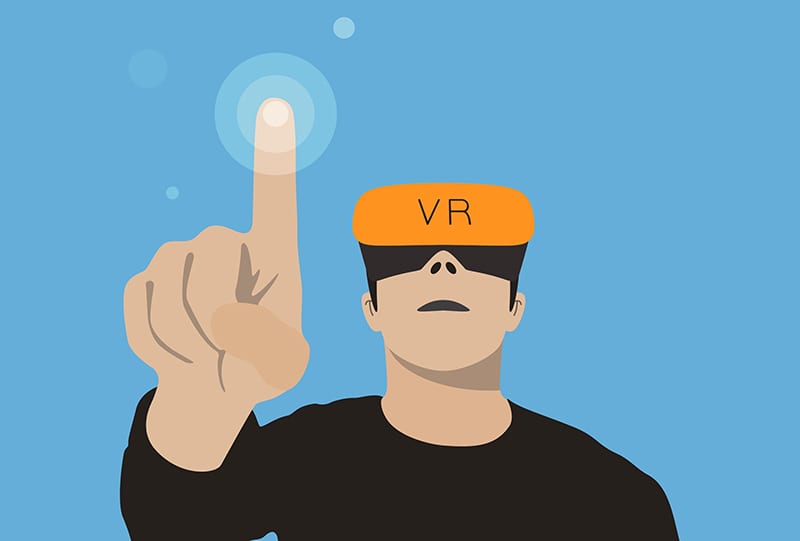Is VR training more efficient than other learning methods?

VR training allows course and training providers to offer more efficient training with a higher degree of security at a lower cost. But how effective is VR training for learning?
VR training, also referred to as Virtual Reality Based Training (VRBT), is an interactive and dynamic teaching method that uses technology to simulate real-life situations.
Also read: Can VR revolutionize training?
How efficient is VR training for learning?
It is not always easy to gain new knowledge.
The prominent German psychologist Hermann Ebbinghaus, showed in the 1880s just how difficult it is for people to remember new information through what he called “The forgetting cure”.
It was shown that in training situations where oral and image-based learning methods are used, the average person will forget about 50 percent of the information retained during the first hour.
Furthermore, the next day, they will have forgotten about 70 percent of the details, and without repeating the content, only 10 percent of the information will be retained after a month.
How much would we remember if VR were the learning method used?
New knowledge has a higher retention rate
The National Education Association of the United States provides details on the learning retention of the most common learning methods we have today.
Learning retention refers to the process by which new information is transferred from the short-term memory to the long-term memory. In other words, it essentially involves gaining new knowledge.
While the learning retention is only 5 percent for lectures and 10 percent for reading, we find VR among the top 2 with a learning retention of 75 percent. VR training is only beaten by learning that happens through educating others, where the learning retention is at 90 percent.
Computer and tablet beaten by VR
Researchers at the University of Maryland conducted one of the first in-depth analyzes of VR training. The goal was to determine if people learn better through virtual, engaging environments, than in more traditional settings, such as the use of a two-dimensional desktop computer or a handheld tablet.
Moreover, 40 percent of participants in the study scored at least 10 percent higher on learning retention when using VR than when using a computer or tablet. The researchers therefore concluded that people remember information better if it is presented to them in a virtual environment.
But why is it so?
The science behind why VR works in education
There are several reasons why VR training is effective in moving new knowledge from short-term memory to our long-term memory.
Here are three explanations:
It brings learning into the real world
Firstly, Research in neuroscience and psychology has revealed that the brain creates a mental map of an environment via the information it collects through our five senses.
The information then becomes part of our perception of reality. The more information we get through the senses, the more developed the mental maps become. When we then end up in a situation that seems familiar, the brain will be able to retrieve these maps and thus, predict what is going to happen next.
However, when the brain has no practical experience and thus, no clear mental map related to a situation, it becomes difficult for us to predict what will happen. Without practical experience, our reactions are based on unsorted and abstract information that we have stored in our memory.
VR technology helps our brain create clear mental maps without having to experience the real world situation. VR helmets make sure to immerse the user completely in the virtual simulation by closing the senses from the real world, so that the brain believes that the virtual world is real. The brain is switched on and neural connections needed for learning and memory are strengthened. In a simulated environment, the brain sees and does exactly what it takes.
In other words, the virtual world enables us to store more complete forms that are easier to remember and that makes it easier to respond to similar situations in the real world.
- Increase training management efficiency
- Convert more participants
- Automate routine tasks and free up time
- Get more time for value creation
- Grow profitable
Customized repetition training
Secondly, it is common knowledge that repetition is good for learning. With VR technology, it is easier to perform frequent repetition training as often as an individual needs it, in order to gain new knowledge. Not only does VR technology facilitate many repetitions, but it also allows for repetitions of certain topics that the individual has a particular need to repeat further.
Shorter training sessions
Finally, brain science shows that learning happens more effectively if you divide the training into shorter sessions with many breaks instead of long sessions with few breaks.
With VR technology, training can be done on demand and with as long and many breaks as needed. This provides a much better learning effect than full repetitive training days with few interruptions.
Is VR the best method for all types of learning?
As we have already seen, training in a virtual reality setting aid the knowledge retention rate and stay in the long-term memory.
But is VR training a good learning method for all types of learning?
In a previous blog post, “Can VR Revolutionize Training?”, I mentioned Virtual Reality Lab at the University of Copenhagen’s Institute of Psychology and their research on VR and learning outcomes.
The experiments that were carried out showed that VR is less useful when it comes to learning factual content, but has great potential to provide increased learning outcomes if used for hands-on training, repetition and amount training. Additionally, the researchers found that VR technology in many cases works best as a supplement to regular teaching.
Also read: Can VR revolutionize training?
Bring VR into the classroom
Research shows that VR training has a number of benefits, including learning. VR technology improves memory and learning becomes more effective. In other words, if you want to provide training with the best learning effect, you should consider bringing VR technology into the classroom.
Did you like this article? Don’t forget to share it:
About FrontCore
Over 2700 training providers use solutions from FrontCore – and that’s not without reason. FrontCore is one of Norway’s leading competence environments within cloud based systems for Training Management and Webmarketing. With over 19 years of experience from the training industry and our finger on the market pulse continuously, we help course and training providers achieve more efficiency and higher revenue.
Get your tasks done with Checklist Template for Courses
Products


Discover the New Era of E-Learning with FrontCore’s Officially Launched LMS
It’s here. We’re launching FrontCore LMS: A user-friendly, AI-enhanced learning management platform for modern e-learning. Experience intuitive design and innovative features with FrontCore’s new LMS. Start your next-gen e-learning journey today!
Unlock the Future of E-learning – The Next-Gen LMS Preview is Now Live!
Ready to elevate your e-learning game? FrontCore is launching a groundbreaking LMS that will not only change the way you create e-learning but also focuses on maximizing learning outcomes. Test the pre-launch version and be a part of shaping the future of e-learning!
Optimize Your ChatGPT-4 Experience with Custom Instructions: A Guide for Training Providers
Boost your training game with ChatGPT-4 Custom Instructions. Get brand-aligned content that speaks to your audience—effortlessly.










0 Comments